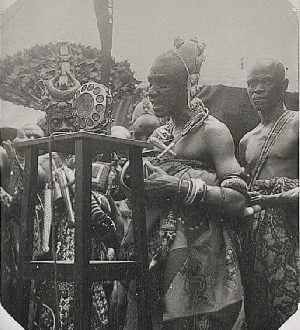The Asante Kingdom is celebrating 88 years since it was restored as a monarchy in Ghana.
The commemoration is also a reminder of when the title, Otumfuo, first came into force.
Being the King of the Ashantis at the time of this restoration of their kingdom, Sir Osei Agyeman Prempeh II became the first person to use the title, Otumfuo.
Hence, he became known as the Asantehene, Otumfuo Osei Agyeman Prempeh II.
Sir Arnold Wienholt Hodson, the Governor of the Gold Coast in 1935, was the one who declared “the Restoration of the Ashanti Confederacy,” on January 31.
Return of Agyeman Prempeh I to the Gold Coast and the restoration of the Ashanti kingdom:
According to information from the Ghanaian Museum, the British broke up the kingdom in the Gold Coast in 1896 when they imprisoned Asantehene Prempeh I and sent him to Sierra Leone and subsequently the Seychelles Island. Fear of Asante power, one whose benefits were the confederacy itself, also played a role in the Asante confederacy’s demise.
British officials had to consequently dismantle the Confederacy in order to replace the Asante power. Governor Sir Frederick Mictchell Hodgson unsuccessfully attempted to take control of the Golden Stool in 1900, which, together with the Asantehene and council, served as a symbol of Asante unity and power, for the same reason.
Following the Yaa Asantewaa War in 1901, the British declared Asante to be a Crown Colony, and the British Chief Commissioner of Asante eventually took on many of the duties of the Asantehene.
However, during the early years of British rule in Asante, Asante native institutions reacted negatively to British interference, which caused the British to face significant administrative challenges.
The growing antagonism between the young and the old highlighted the collapse of Asante society’s political and social order. This required periodic administrative measure revisions by the British. For instance, the government had to revise the native jurisdiction ordinance from 1924 in 1927 as a result of the widespread disturbance in Asante.
The majority of the residents of the town who did not initially pledge allegiance to the chief of the division were given the authority to form a council by the chief commissioner of Asante as a result of this change. For instance, in 1929, the stools of Amoaful and Essumegya lost their authority and were no longer treated as Amanhene (Paramount Chiefs), instead they were treated as ordinary Odikro. They were also instructed to treat the Omanhene of Bekwai as their immediate overlord.
However, the British’s administrative actions in Asante did not have the anticipated effect; instead, they made it possible for the government to lose control of the situation. The British chose to reinstate these institutions in order to reinforce their administrative authority over Asante after realizing that the interference with Asante traditional institutions had set off a chain of events that led to issues.
It was widely agreed that the restoration of Asante institutions could be able to salvage the situation and make British administrative control simpler as administrative issues multiplied, especially around 1922.
Mr. Fiddian, in the colonial office, and Governor Guggisberg shared this opinion. It is also known that Mr. Thomas of the Colonial Office voiced the opinion that the Gold Coast Administration’s reinstatement of the Asante Confederacy would address the challenging issue of local government that had long bothered the British.
The Asante themselves wanted the institutions back and repeatedly asked the government for permission in this regard, which is what led to their reinstatement. Prempeh I, the former Asantehene, was requested to be repatriated by the Asante in 1914, 1918, and 1919. The Kumasi division demanded the return of villages that had once belonged to Kumasi chiefs in 1924–1925, and the populace as a whole reiterated their demand for Prempeh to be reinstated as Kumasihene.
The tremendous outrage in the nation at the vandalism of the Golden Stool is another occurrence that supports the Asante’s loyalty to their institutions. In turmoil, the government naturally believed that by giving in to the Asante’s requests, it would win their respect and goodwill and that their participation would make administration simpler.
Due to these circumstances, Asantehene Prempeh I was repatriated by the Gold Coast Government in 1924. A few years later, they took things one step further and reinstated him as Kumasihene. Prempeh II, who had taken Prempeh I’s place as Kumasihene in 1931, was proclaimed Asantehene in 1935, and the Asante Confederacy was once again united.
Kumasi, Mampong, Juaben, Bekwai, Essumegya, Kokofu, Kumawu, Nsuta, Adanse, Ejisu, Offinso, and Agona made up the new Confederacy. The Brong districts of Banda, Wenchi, and Mo also voluntarily joined the Confederacy. Therefore, the districts of Obogu, Denyase, Bompata, Manso Nkwanta, and Ahafo were reincorporated into the division. The Asante divisions’ long-standing allegiances were now formally recognized.
Stability and happiness resulted from the restoration of Asante traditional institutions. Akrodie, an Ahafo village, and Bekwai issues were personally resolved by Otumfuo Sir Osei Agyemang Prempeh II after matters in the provinces were once again sent to Kumasi chiefs.
By stating his own customary rights in connection with these cases, he also dispelled the uncertainty that had developed in Asante over the Great Oath issues. It took Otumfuo Sir. Osei Agyemang Prempeh II to bring peace to Asante. He resolved Agona chieftaincy matters that the Colonial Government was unable to do so within a year of his appointment.
The British Administration was able to establish a stronghold over the nation through the Asantehene and the Asante Confederacy. Nevertheless, Asante remained a distinct crown colony up until the Ghana Independence Act of 1957, when it was merged into the new nation of Ghana.
88 years on:
In a tweet by the Asante Nation on Twitter, it celebrated the occasion of the anniversary, while indicating how significant that moment was because it was also the moment the use of the title, “Otumfuo” came into force.
“Exactly 88 years today (on 31st January 1935), Asanteman was restored to its glory under Otumfuo Sir Osei Agyeman Prempeh II. He was the first to use the title ‘Otumfuo,’” the tweet read.
The currently Asantehene is Otumfuo Osei Tutu II, who installed on April 26, 1999. He enters his 24th year as the king of the Ashanti kingdom in 2023.
Source: www.ghanaweb.com
 Home Of Ghana News Ghana News, Entertainment And More
Home Of Ghana News Ghana News, Entertainment And More





